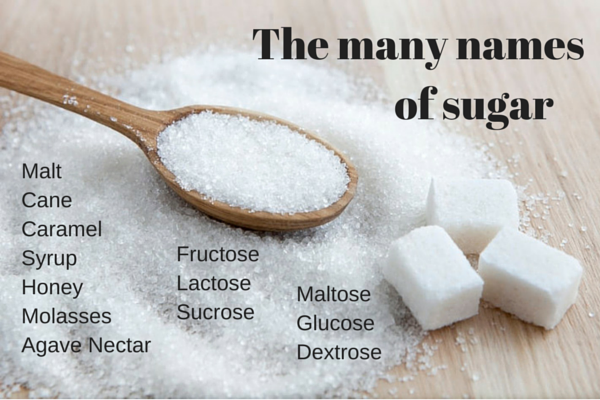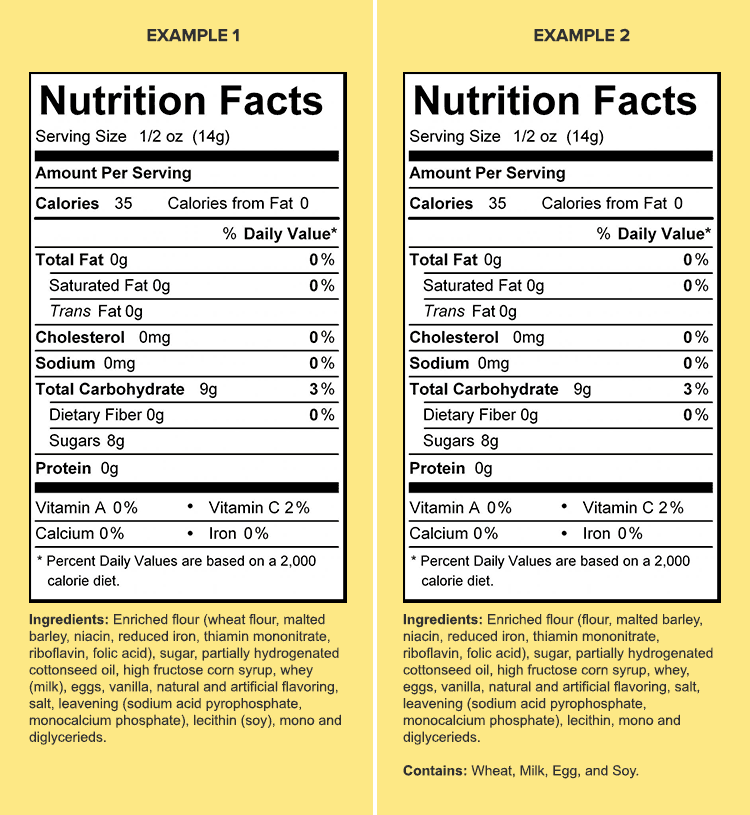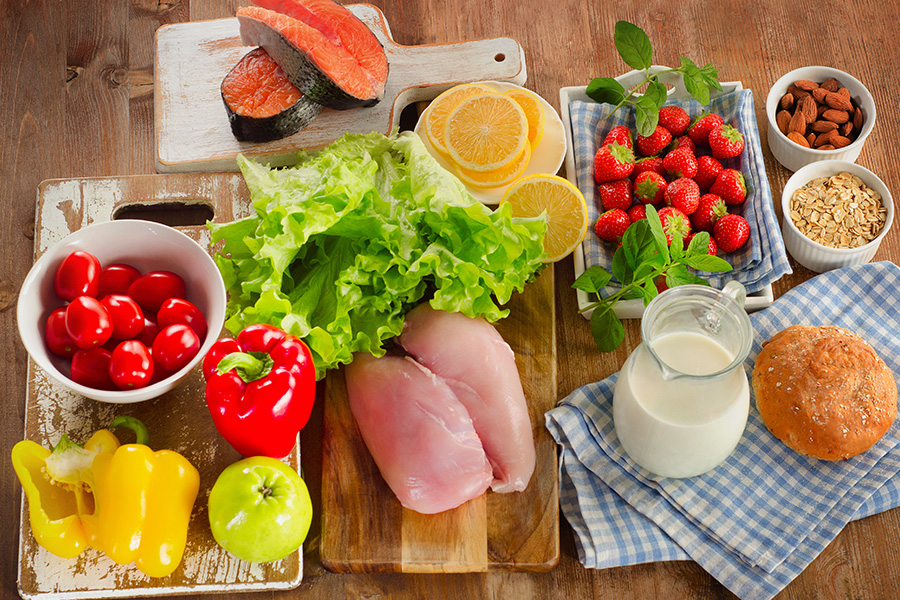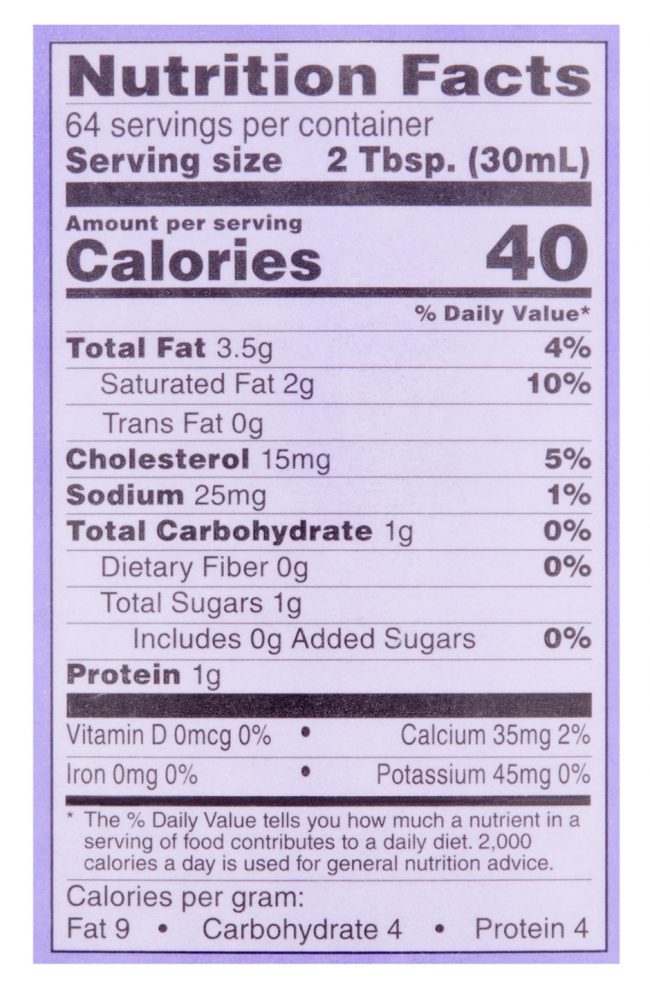44 nutrition labels for common foods
Food Labeling & Nutrition | FDA Food labeling is required for most prepared foods, such as breads, cereals, canned and frozen foods, snacks, desserts, drinks, etc. Nutrition labeling for raw produce (fruits and vegetables) and... Nutritional Values For Common Foods And Products Nutritional Values For Common Foods And Products. Daily values are based on a 2000 calorie a day diet. Recommended daily intake of essential aminoacids is provided for 180 lbs person. Actual daily nutrient requirements might be different based on your age, gender, level of physical activity, medical history and other factors.
Nutrition Facts Label Size Requirements - LabelCalc Here are some of the common guidelines every food manufacturer should be aware of: "Nutrition Facts" lettering must be bigger than any other font on the nutrition label (except for the numerical value for calories) and must span the length of the whole nutrition facts panel. The smallest font sizes that can be used on the nutrition facts ...
Nutrition labels for common foods
Food Labels: Read It Before You Eat It! - American Academy of Allergy ... Milk (from cow). However, someone allergic to cow's milk would likely react to milk from sheep, goats and maybe camels. 2. Eggs (from chickens). However, someone allergic to chicken egg would also likely react to eggs from other birds. 3. Fish (fin fish including bass, flounder, trout, cod, salmon, shark and skate) 4. PDF Eat Right Food, Nutrition and Health Tips from the Academy of Nutrition and Dietetics Shop Smart— Get the Facts on the New Food Labels Become a smart shopper by reading food labels to find out more about the foods you eat. The Nutrition Facts panel found on most food labels will be changing in the near future, and the updates will help you: PDF Newsletter- Snacks and Food Labels (Read-Only) most foods, but can also be added. Many processed foods are high in added sugars and therefore contain "empty calories", meaning they have no nutritional value and should be limited. Here is a list of the most common claims on food labels and what they really mean according to the Food and Drug Administration (FDA) regulations:
Nutrition labels for common foods. Nutritional Values For Common Foods And Products Nutritional Values For Common Foods And Products. Daily values are based on a 2000 calorie a day diet. Recommended daily intake of essential aminoacids is provided for 180 lbs person. Actual daily nutrient requirements might be different based on your age, gender, level of physical activity, medical history and other factors. nutritiondata.self.com - Food Facts, Information & Calorie ... Food label accuracy of common snack foods - PubMed Food label accuracy of common snack foods Serving size, by weight, exceeded label statements by 1.2% [median] (25th percentile -1.4, 75th percentile 4.3, P = 0.10). When differences in serving size were accounted for, metabolizable calories were 6.8 kcal (0.5, 23.5, P = 0.0003) or 4.3% (0.2, 13.7, P = 0.001) higher than the label statement. … Food Labels & Nutrition Facts - Ask the Dietitian® Food Labels & Nutrition Facts Does the US Dietary Guidelines in calling for no more than 10% of calories from sugar mean a) added sucrose, b) sucrose, added or naturally occurring, or c) all simple sugars (fructose, glucose, lactose, sucrose, etc.)?
How to Understand and Use the Nutrition Facts Label | FDA Feb 25, 2022 · Overview. The information in the main or top section (see #1-4) of the sample nutrition label (below) can vary with each food and beverage product; it contains product-specific information ... Nutrition Labels 101: What's Required? What's Optional? Total carbohydrates is a required listing unless there is less than 1 gram, at which point it can be expressed as "contains less than 1 gram," or if less than 0.5 grams per serving, it can be expressed as zero. Sugars are the sneaky nutrient found naturally in many "healthy" foods, including fruit and milk. Your Ultimate Guide to Food and Nutrition Labels - Aaptiv What complicates things is that they're regulated differently for certain types of foods. When it comes to something marketed as low sodium, Taub-Dix explains that it contains 140 or fewer milligrams of sodium. On the other hand, foods marketed as low calorie need to have 40 calories or fewer per serving. "Light" is similar in that way. Understanding Food Labels | The Nutrition Source | Harvard T ... Chile implemented the Law of Food Labeling and Advertising in 2016, comprised of mandatory front-of-package (FOP) warning labels, restrictions on child-directed marketing, and the banning of sales in schools of all foods and beverages containing added sugars, sodium, or saturated fats that exceeded set nutrient or calorie thresholds. [1]
Nutrition Label Glossary: Definitions of Nutrition Fact Terms - WebMD This number on a food label indicates how much fat is in a single serving of a food. Limit total fat to less than 25% to 35% percent of the calories you consume each day. All fats have 9 calories ... Food labels: nutritional information and ingredients 23 Sept 2020 ... Nutritional information panels on food labels list energy, protein, fat, carbohydrates and sodium. · Nutritional information panels are a better ... Can food labels influence dietary choices? - Medical News Today A recent systematic review suggests that color-coded nutrition food labels and warnings on food packaging correlate with healthier food choices. The researchers, from Australia, Canada, New ... Making the Most of the Nutrition Facts Label Infographic Eat foods with nutrients your body needs like calcium, dietary fiber, iron, potassium, and Vitamin D. % Daily Value. The % Daily Value (DV) tells you the percentage of each nutrient in a single serving in terms of the daily recommended amount.
Understanding Food Nutrition Labels | American Heart Association When the Nutrition Facts label says a food contains "0 g" of trans fat, but includes "partially hydrogenated oil" in the ingredient list, it means the food contains some trans fat, but less than 0.5 grams per serving. So, if you eat more than one serving, you could end up eating too much trans fat.
How to Decode a Nutrition Label - Healthline Nutrition labels, coming 2021 The coming changes to the label intend to make interpretation a little easier. Updates like a larger, bolded font for calories and more realistic serving sizes (no...
School Nutrition Training Needs Regarding Food Sensitivities And Food ... The eight most common food allergies are milk, eggs, peanuts, tree nuts, fish, shellfish, soy, and wheat (U.S. Food & Drug Administration [FDA], 2017). ... have laws that all ingredients, including potential allergens, be stated on the food label (USDA, 2016). Further, potential contact with any of the eight common allergens must also be listed ...
The Basics of the Nutrition Facts Label - Academy of Nutrition and ... Step 4: Check Out the Nutrition Terms. Low calorie: 40 calories or less per serving. Low cholesterol: 20 milligrams or less and 2 grams or less of saturated fat per serving. Reduced: At least 25% less of the specified nutrient or calories than the usual product. Good source of: Provides at least 10 to 19% of the Daily Value of a particular ...
55 Sneaky Words on Food Labels You Need to Avoid "Apart from the obvious places, if you look on a label you'll find it in unlikely places, such as hamburger buns, French fries, potato chips, and processed meats. It may be called something other than 'sugar.' Cane sugar, sucrose, fructose, agave nectar, high fructose corn syrup—but sugar is sugar, no matter how you spell it."
Healthy Swaps for Common Foods | American Heart Association Jan 01, 2015 · These oils contain monounsaturated and polyunsaturated fats. Check the Nutrition Facts label and avoid foods with hydrogenated oils. Buy lower-sodium versions of common canned recipe ingredients like tuna, beans, tomatoes and other vegetables. If you can’t find low-sodium or “no salt added,” rinse the contents in a colander under water to ...
Food Labels (for Teens) - Nemours KidsHealth A food with 5% or less of a nutrient is low in that nutrient. A food with 10%-19% of a nutrient is a good source of that nutrient. A food with 20% or more of a nutrient is high in that nutrient. The information on food labels is based on an average adult diet of 2,000 calories per day. The actual number of calories and nutrients that kids ...
How to Get A Nutrition Facts Label for Food Products Nutrition Food Labels Step 2: Play By FDA Rules The FDA requires nutrition labeling to see what ingredients and allergens are in your food product, however, it doesn't test the nutrition of every food product and submitting your nutritional statements is completely voluntary.
Food Labels | CDC - Centers for Disease Control and Prevention If you eat the whole thing, you are eating 8 times the amount of calories, carbs, fat, etc., shown on the label. Total Carbohydrate shows you types of carbs in the food, including sugar and fiber. Choose foods with more fiber, vitamins, and minerals. Choose foods with lower calories, saturated fat, sodium, and added sugars. Avoid trans fat.
When it comes to reading food labels, what's most important? Serving size. Check to see how many servings the package contains. The nutrition numbers on the rest of the label are for a single serving. So if you eat two ...
Feeding Your Cat: Know the Basics of Feline Nutrition ... Canned foods never list the calorie content on the can but many dry foods do list this information on the bag. A rough guideline for the calorie content of most canned foods that are 78% moisture is ~30 calories/ounce but can range from 20 to 40 calories/ounce as shown by the chart linked above.
How to Read Food Labels Without Being Tricked - Healthline Nutrition labels state how many calories and nutrients are in a standard amount of the product — often a suggested single serving. However, these serving sizes are frequently much smaller than what...
Food labels - NHS These labels provide information on the number of grams of fat, saturated fat, sugars and salt, and the amount of energy (in kJ and kcal) in a serving or portion of the food. But be aware that the manufacturer's idea of a portion may be different from yours. Some front-of-pack nutrition labels also provide information about reference intakes.
How To Read Food and Beverage Labels - National Institute on Aging Or you can call the U.S. Department of Agriculture's Food and Nutrition Information Center at 301-504-5414. Understanding percent Daily Value (% DV) The percent Daily Value (% DV) tells how much a nutrient in a serving of the food or beverage contributes to a total daily 2,000-calorie diet.
Common Information on Food Labels - University of Kentucky The Nutrition Facts label gives information about the total number of servings in the package, the size of one serving, number of calories, and nutrients in the food. The label also uses percent Daily Values (DV) which are average levels of nutrients for a person eating 2,000 calories a day.
Food Labels | Nutrition.gov HHS, Food and Drug Administration, Center for Food Safety and Applied Nutrition Learn the difference between total sugars and added sugars, and discover how the Nutrition Facts Label can help you choose foods that are lower in added sugars. Folate and Folic Acid on the Nutrition and Supplement Facts Labels
PDF Nutrient Value of Some Common Foods - canada.ca Nutrient Valueof Some Common Foods 4 Breads, Cereals and Other Grain Products Food Name Measure Weight Energy Energy Protein Carbohydrate Total Sugar Total Dietary Fibre Total Fat Saturated Fat Cholesterol Calcium Iron Sodium Potassium Magnesium Phosphorus Thiamin Ribofl avin Niacin Folate g kcal kJ gggggg mgmgmgmgmgmgmgmgmgNEDFE
Nutrition facts tables - Canada.ca How to use a nutrition facts table · learn about a food's nutritional value (calories and nutrients) · see if a food contains a little (5% DV or ...









Post a Comment for "44 nutrition labels for common foods"